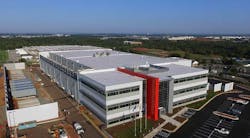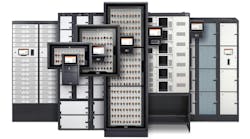QTS Comes Online in Ashburn, With a Big Building and Bigger Ambitions
ASHBURN, Va. – In many ways, QTS Data Centers is just getting started with its operations in “Data Center Alley,” the world’s largest cluster of cloud data centers. QTS has opened its first company-built facility here, and installed an anchor customer. The sales team is busy giving tours to prospective customers.
As it goes through the familiar rituals of entering a new market in Northern Virginia, QTS is quietly playing a longer game. That’s reflected in the scale of QTS Ashburn, a 32-megawatt facility that is the first three-story data center in Loudoun County. Once this building is filled, the 24-acre property will support a second 16-megawatt data center. About 1,000 yards to the West, QTS owns a 30-acre property, where it plans to deploy another 105 megawatts of capacity.
In March, QTS acquired 61 acres of vacant land in Manassas in nearby Prince William County, where it is building a new campus that will support more than 85 megawatts of power. QTS announced the deal in conjunction with a 24-megawatt data center lease with a global cloud company to anchor the campus.
Looking To the Clouds
Between the three campuses, QTS has the ability to develop nearly 215 megawatts of data center space in Northern Virginia,. That’s a big change from just 18 months ago, when QTS had a modest presence in the region, operating a single data center in Sterling focused on federal and government IT customers.
The facility, known as the Vault, was originally built by Carpathia Hosting, which was acquired by QTS in 2015. With 32,000 square feet of hosting space, the site is too small to compete for the large-footprint deals that have defined recent growth trends in Data Center Alley.
The sharpened focus on Ashburn is part of a larger transition for QTS, which in February restructured to target the hyperscale opportunity. That required a major step back from in-house cloud computing and managed services, which had been a pillar of its “3Cs” approach to the market. In April QTS said it had entered into a strategic partnership with GDT, which will take over 200 customers from QTS.
QTS says its will focus on providing colocation “on-ramps” to major clouds, rather than delivering those cloud services itself.
Ashburn: Home of the Hyperscalers
If you want to play the hyperscale game, you need a major presence in Ashburn, the Home of the Hyperscalers. Northern Virginia houses nearly 1 gigawatt of data center capacity, and is in the midst of an extraordinary burst in leasing and land acquisition. So in mid-2017 QTS bought two properties in Ashburn to house company-built data centers.
“Our whole mission was to be in the right locations and deliver at the right speed,” said Tag Greason, the Chief Hyperscale Officer at QTS. “We’re building from a hyperscale perspective. We’re building in bulk to improve our economics.”
A power room inside the QTS Ashburn data center. (Photo: Rich Miller)
QTS executives say the company’s commitment to hyperscale has opened doors, making QTS a serious player in huge deals that will shape its future. QTS has long been the master of the Internet-scale retrofit, finding former industrial facilities with sturdy infrastructure and transforming them into massive data centers The size of its buildings allow QTS to create custom data centers within the footprint of a larger facility.
The recent growth of cloud computing has super-sized the requirements for hyperscale customers, which now range from 5 megawatts to as much as 35 megawatts of space in major markets. With its shift in strategy, QTS is now competing for deals ranging from 4 megawatts to 40 megawatts.
Facilities Drive Deployment
Competing for hyperscale deals requires more than a sales philosophy. Hyperscale success is built upon a foundation of facilities that can be delivered quickly and offer room for expansion.
The QTS Ashburn data center illustrates how its data center design is being optimized for this new focus. The project reflects a shift in development strategy, with QTS pursuing “greenfield” construction on open land rather than retrofitting an existing building.
A cooling equipment corridor in the QTS Ashburn data center. (Photo: Rich Miller)
The 427,000 square foot structure features 60,000 square feet of office space at the front of the building, along with 12 data halls (four on each floor) that can each support 2.66 megawatts of power. The building will be supported by up to 18 emergency backup generators. QTS expects to operate the facility at a design PUE of 1.18. The anchor tenant occupies an entire data hall on the ground floor.
QTS houses the cooling infrastructure in an equipment corridor that runs alongside each data hall, moving the computer room air handlers (CRAH units) off the data center floor. This provides more data hall space for servers, and also allows the QTS team and vendors to maintain the equipment without entering the secure customer suite.
Why the Supply Chain Matters
An emerging challenge in the hyperscale market is the speed of the supply chain, where providers are facing lengthening lead times for some types of power distribution equipment.
As a result, Greason says QTS has joined the providers that are buying equipment ahead of time and storing it for delivery when a customer needs a speedy deployment.
“We’re buying that equipment knowing that we can ship it to Ashburn or Dallas when it’s needed,” said Greason, who said the equipment is typically housed in storage facilities near the manufacturer.
QTS is also among the providers offering a hybrid lease structure to allow hyperscale customers to reserve huge buildings that are pre-wired with power and fiber, and then gradually build out finished data center space.
QTS said its Manassas customer will lease the full 24 megawatt powered shell up front, and occupy five megawatts of turn-key data center capacity within the shell upon lease commencement. The customer is expected to sign future commitments, scaling to the full 24 megawatts of turn-key power capacity over approximately two years. The initial lease is expected to commence in the first quarter of 2019.
Greason says the deal allows the company a 180-day lead time to deliver the next 5 megawatts.
“I believe there’s a subset of the hyperscale market, and it has four or five players,” said Greason. “These customers want 24 to 36 megawatts as fast as you can give it to them. The rest of the hyperscalers are more measured. They want a roadmap for their next 20 megawatts, where their future is protected.”
About the Author



